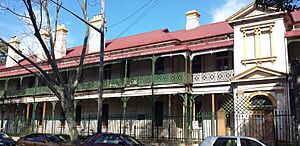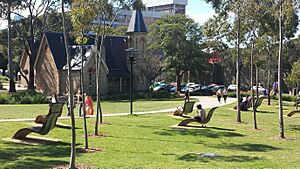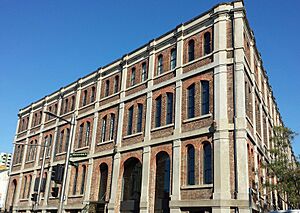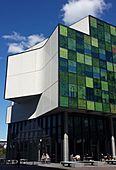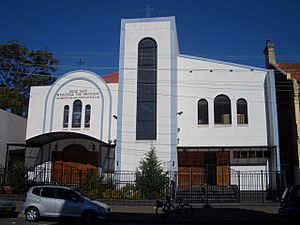Darlington, New South Wales facts for kids
Quick facts for kids DarlingtonSydney, New South Wales |
|||||||||||||||
|---|---|---|---|---|---|---|---|---|---|---|---|---|---|---|---|

Old Darlington school survived the University of Sydney expansion and is located in Maze Crescent
|
|||||||||||||||
| • Density | 4,486/km2 (11,620/sq mi) | ||||||||||||||
| Postcode(s) | 2008 | ||||||||||||||
| Area | 0.5 km2 (0.2 sq mi) | ||||||||||||||
| Location | 3 km (2 mi) south of Sydney CBD | ||||||||||||||
| LGA(s) | City of Sydney | ||||||||||||||
| State electorate(s) | Newtown | ||||||||||||||
| Federal Division(s) | Grayndler, Sydney | ||||||||||||||
|
|||||||||||||||
Darlington is a small suburb located close to the centre of Sydney, New South Wales, Australia. It is about three kilometres south of the main city area, known as the Sydney central business district. Darlington is part of the City of Sydney local government area.
When it became an official town in 1864, Darlington was the smallest town in the Sydney area. It was only about 44 acres big. Darlington is surrounded by streets like City Road, Cleveland Street, Golden Grove Street, Wilson Street, and Abercrombie Street.
Contents
History of Darlington
First Peoples of Darlington
The original inhabitants of the Darlington area were the Cadigal people. They are part of the larger Eora nation, who spoke the Dharug language. The Cadigal people lived near the coast. They found food by fishing, hunting land animals, and gathering shellfish and plants. Darlington was part of their southern lands.
Early European Settlement
The first European records of Darlington are about land set aside for schools. In 1789, Governor Arthur Phillip was told to save land for churches and schools. Later, in 1819, Governor Lachlan Macquarie gave 52 acres of land to William Hutchinson.
In 1835, William Shepherd received a grant of 28 acres. This land was promised to him earlier by Governor Ralph Darling. Shepherd named his fruit and flower farm 'Shepherd's Darling Nursery' to honour Governor Darling. Many streets in Darlington today, like Ivy, Pine, Myrtle, Rose, Vine, and Shepherd Streets, remember his nursery.
By 1844, much of what is now Darlington included land from Hutchinson's estate, Shepherd's Nursery, and land given to William Chippendale.
Growth and Industry
In the late 1850s, the University of Sydney was built north of Darlington. Darlington officially became a town on 16 September 1864. The first council was then chosen. The suburb's name might come from Governor Ralph Darling or from William Vane, the 3rd Earl of Darlington.
Darlington grew quickly in the 1880s. By 1891, it was very crowded and had many poor living conditions. It was the most densely populated suburb in Sydney. In the late 1890s, the Eveleigh Railway Workshops were built. Many local people worked there. Other businesses in Darlington at this time included a jam factory, metal works, and factories making cabinets, drinks, and boots.
University Expansion
In the late 1950s, the Government of New South Wales changed the rules for 70 acres of Darlington. This land was set aside for government groups like the Department of Housing and the University of Sydney. The university wanted to expand its campus into Darlington.
Because of this, about 650 houses were knocked down. Shops, factories, banks, the old town hall, and other buildings were also removed. Around 2,000 people had to move out of Darlington. Since the 1990s, most factories have closed. The suburb has been rebuilt with more homes and new developments.
Shopping and Services
Abercrombie Street, near Lawson Street, is now the main shopping area in Darlington. This happened after the university expanded in the 1960s. You can find cafes, restaurants, small grocery stores, and other businesses here. There are also businesses inside the Sydney University Darlington campus. Other nearby shopping areas include Broadway Shopping Centre, King Street, Newtown in Newtown, and Redfern Street.
Parks and Green Spaces
Sydney University's Cadigal Green is the biggest park in Darlington. It has the old Darlington School, places to sit, and a wetland area. Charles Kernan Reserve on Abercrombie Street is named after a local person. It has a playground, public BBQs, and a community garden. Other parks include the Vine Street playground and a small park at Boundary and Shepherd Streets. Larger parks nearby are Victoria Park, Prince Alfred Park, and Redfern Park.
Architecture and Buildings
Homes in Darlington
The opening of the Eveleigh Railway Workshops in the 1880s led to many homes being built. Most homes were Victorian worker's terraces. These were houses built in a row, sharing side walls. They housed the workers from the railway workshops and other nearby factories. Some older worker's cottages from the 1870s-1880s can still be seen on Thomas and Vine Streets.
-
A social housing estate on Golden Grove Street, near Newtown, built in the 1970s-1980s
Old Factories and Their New Uses
The McMurtrie, Kellermann & Co factory is a well-known building at Abercrombie and Lawson Streets. This old boot factory shows how Darlington grew with industries from the late 1800s to the mid-1900s. It was important for making shoes and later gas meters. The factory was also where big worker strikes happened in 1935. Today, it has been changed into homes and businesses.
The IXL Garage building on Golden Grove Street was built in 1937. It was a garage for the Henry Jones and Company factory. This building shows how industries developed in Darlington in the mid-1900s. It was important for the Australian food processing industry, making jams and canned fruits. The garage was built for delivery trucks, showing how motor vehicles became important for distributing products.
Buildings with New Purposes
Many old buildings in Darlington have been given new uses. This is called "adaptive reuse." For example, the old 'tinshed' industrial site on Wilson and Shepherd Streets is now homes. The former Blue Diamond Furniture factory on Boundary Street has also been turned into homes.
The Old Darlington School was designed in 1877 and opened in 1878. It is a two-storey building with a Gothic Revival style. It has colourful bricks, a spire, and a slate roof. In 1976, it became part of the University of Sydney.
The NSW Institution for the Deaf, Dumb and Blind on City Road was Australia's first school for the deaf. It was built in stages from the 1880s to 1929. The building has a mix of Victorian architectural styles. It features colourful bricks and towers with unique roofs. The superintendent's residence, a large two-storey house, was built in the late 1880s. It shows the importance of the superintendent's job. This residence was renovated in 1990 and is now the Darlington Centre, used for conferences.
Cypress Hall, built in 1858–59 on City Road, is a very old building. It is a Regency villa and is one of the oldest buildings at the University of Sydney. The main part of the villa is still inside the walls of St Michael's College, built in 1929. This villa is one of the few large Regency buildings left in inner Sydney. It is the only known one in Darlington.
Modern Buildings
- Modern architecture in Darlington
The Jane Foss Russell building is on the University of Sydney grounds. It is named after Jane Foss Barff, the first woman to earn a Master of Arts at Sydney University in 1889. This building has many green glass walls and panels of different colours. It has a large outdoor area with seating, event spaces, and cafes. The Gordon Yu-Hoi Chiu Building at the University of Sydney won an architecture award in 1998. The new Abercrombie precinct will be home to the University of Sydney Business School.
Education in Darlington
Darlington Public School is on Abercrombie Street. It teaches students from Preschool to Year 6.
TAFE NSW Eora is a campus of TAFE NSW Sydney Metro on Abercrombie Street. It has been a centre for modern art and Aboriginal studies since 1984. The building used to be the British United Shoe Machine Co. factory.
The Chippendale Child Care Centre on Pine Street, Chippendale, is the closest place for early childhood education.
Sports and Recreation
The Sydney University Sports and Aquatic Centre has swimming pools, tennis courts, basketball courts, and a gym. Victoria Park Pool and fitness centre are also nearby in Victoria Park. Prince Alfred Park on Cleveland Street has tennis courts, basketball courts, and a newly renovated swimming pool. There is also a Seido Karate club on Abercrombie Street.
Arts and Culture
Carriageworks
The old Eveleigh Carriage Workshops are now Carriageworks. This is a place where modern art is created and shown. It has theatre spaces, rehearsal rooms, a gallery, and other facilities. Carriageworks is located off Wilson Street, in the nearby suburb of Eveleigh. The Anna Schwartz Gallery is also inside the Carriageworks complex.
Tin Sheds Gallery
Tin Sheds Gallery on City Road is a modern art exhibition space. It is part of the Faculty of Architecture, Design and Planning at the University of Sydney.
Other Art Galleries
The Sheffer Gallery on Lander Street shows art from new artists. It also hosts exhibitions from other galleries. The Pine Street Creative Arts Centre has a branch at the Darlington Activity Centre on Shepherd Street. Another nearby gallery is the White Rabbit Gallery in Balfour Street, Chippendale. It has one of the world's largest collections of modern Chinese art.
Places of Worship
While many Darlington residents do not identify with a religion, there are several places of worship. These include the Greek Orthodox Parish and Community of "The Dormition of Our Lady" on Abercrombie Street. There is also "St Michael and all the Angels" Melkite Cathedral on Golden Grove Street. The Portuguese Pentecostal Church is also on Abercrombie Street.
Getting Around Darlington
Darlington is served by buses that run along City Road and Cleveland Street. The closest train stations are Redfern and nearby Macdonaldtown.
Darlington Images
Population and People
Darlington's Population
| Historical population | ||
|---|---|---|
| Year | Pop. | ±% |
| 2001 | 2,042 | — |
| 2006 | 2,183 | +6.9% |
| 2011 | 2,243 | +2.7% |
| 2016 | 3,097 | +38.1% |
| 2021 | 2,597 | −16.1% |
In the 2021 census, Darlington had 2,597 people living there.
According to the 2016 census, there were 3,097 residents in Darlington. The average age was 25 years old, which is younger than the Australian average of 38 years old. In Darlington, about 44.8% of people were born in Australia. The next most common countries of birth were China (20.2%), England (3.0%), and New Zealand (2.2%).
About 55.2% of people spoke only English at home. Other languages spoken included Mandarin (19.6%). Many residents (60.9%) reported having 'no religion', compared to 29.6% for all of Australia. The next most common religions were Catholic (9.9%), Buddhism (4.3%), and Anglican (3.2%). About 81.5% of residents had never been married, which is much higher than the Australian figure of 35.0%.
Famous People from Darlington
- Alfred Shout VC (a brave soldier)
- Cliff Lyoff Amadio (a saxophonist and clarinettist)
- Frank Burge (a Rugby League player)
- Eddie Ward (a politician in the Labor Party)
- James Robert Tyrrell (a bookseller)


